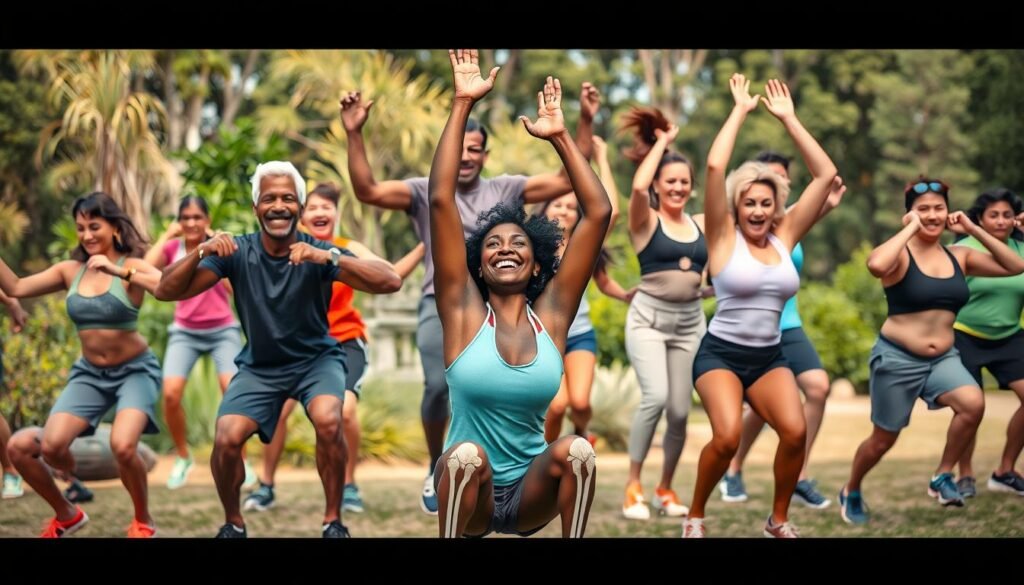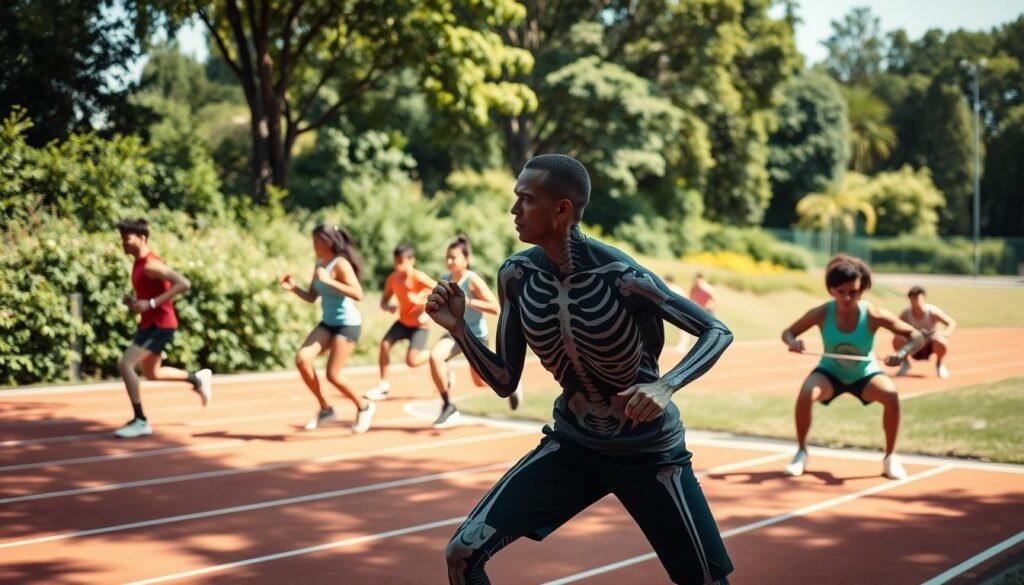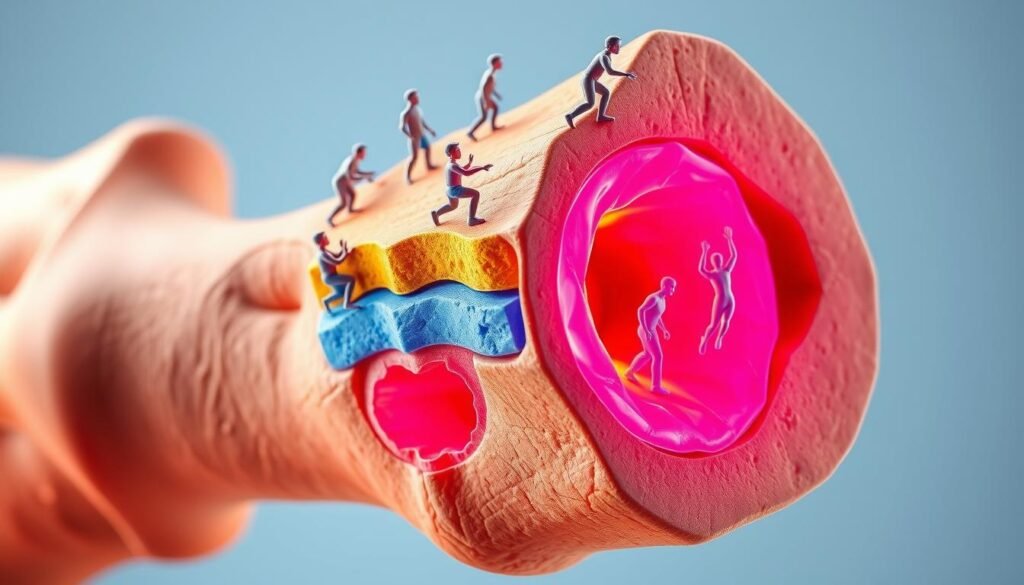Did you know over 75 million people are fighting osteoporosis in the US, Europe, and Japan? This big number shows we need to act now for better bone health. Exercise isn’t only great for staying fit; it’s key for strong bones too. By doing weight-bearing and strength-training exercises, people of all ages can increase their bone density. This helps make your skeleton stronger throughout your life.
Key Takeaways
- Regular physical activity helps build and maintain healthy bones.
- Weight-bearing exercises can prevent further bone loss and strengthen bones.
- Strength training creates stress on bones, contributing to bone-building capacity.
- Increased bone density has been observed in adults engaging in consistent loading exercises.
- Balance training can reduce the risk of falls significantly.
Introduction to Bone Health and Physical Activity
Bone health is crucial for our well-being but often ignored. Doing physical activity regularly helps keep bones strong. This is important starting in childhood. Kids and teens should get 60 minutes of active play every day. This includes exercises that make the heart beat faster and strengthen bones.
As people get older, their exercise needs change. Adults should aim for 150 to 300 minutes of moderate exercise each week. They also need strength exercises twice a week. For older folks, staying active is key, focusing on balance to prevent falls.
Being active helps increase bone mass until about age 35. After that, we start to lose bone density. An active lifestyle benefits us in many ways. It keeps muscles strong and improves balance. This helps avoid osteoporosis. Regular exercise also helps bones stay healthy over time.
Activities like walking and dancing are great for bones. But not all exercises help with this. Swimming and cycling, for example, don’t build bone strength. So, it’s good to do different kinds of exercises. This includes ones that build endurance and muscle.
Understanding how physical activity helps bone health is key. It shows why it’s important to be active from a young age and keep it up. This can prevent weak bones and diseases like osteoporosis, which many people face.
Many things affect bone health, like diet, genes, and how we live. Eating foods rich in calcium and vitamin D is important. So is staying away from tobacco and alcohol. Making these healthy choices part of daily life supports active, healthy living.
Understanding Osteoporosis and Its Impact on Bone Health
Osteoporosis is a major health issue marked by low bone density and high bone fragility. It affects over 75 million people worldwide, showing the critical need for awareness. Often, people don’t notice symptoms until they break a bone, especially older individuals. As people get older, their fracture risk goes up. It’s noted that one in two women and one in five men over 50 will face this risk.
Being active is key to maintaining and building bones, helping lower fracture risks. For girls before puberty, starting physical activity can boost bone size and strength, setting them up for healthier bones later. For women after menopause, getting enough calcium is vital for the positive effects of physical activity on bones.
As people age, they often lose bone faster than they can make it. After hitting 50, individuals can lose 1-3% of their bone mass every year without treatment. Understanding risks like overactive thyroid, smoking, and too much alcohol helps lessen osteoporosis risks. Women over 50 and men over 70 should get 1,200mg of calcium daily.
Osteoporosis doesn’t just affect those with the condition; it leads to higher healthcare costs from fractures. Knowing about osteoporosis and taking steps early on is vital for better health. Doing weight-bearing exercises and getting enough vitamin D and calcium are great ways to combat bone fragility. For tips on keeping bones strong, visit this resource.
Physical Activity: A Key Player in Bone Strength
Being active is crucial for building and keeping bones strong. When we move a lot, especially in ways that make our bones work harder, it helps build bone thickness. This thickness is key in fighting off diseases like osteoporosis. It’s important to know which exercises are best for healthy bones.
The Role of Weight-Bearing Exercise
Weight-bearing exercises, like running, dancing, and playing sports, are great for bones. Research shows that when these activities make the ground push back hard against us, it helps our bones grow stronger. This is especially true for kids and teens, as their bones are still developing.

How Strength-Training Contributes to Bone Density
Strength-training is just as key for bone density as other exercises. It grows stronger muscles and bones by making them work against resistance. To really benefit our bones, it’s best to stick with a strength-training plan that’s 30 minutes long, three to four times a week. We need to mix up our workouts and watch out so we don’t overdo it, which could actually be bad for our bones.
Types of Exercises Beneficial for Bone Health
Doing different exercise types is key for good bone health. Each kind focuses on boosting bone strength in its own way. Knowing what each exercise offers helps us make better workout plans.
Weight-Bearing Impact Exercises
Weight-bearing impact exercises are great for the bones. People perform these on their feet, adding force that benefits the bones. Activities include:
- Brisk walking
- Stair climbing
- Jogging or running
- Jumping activities
Running and skipping, at a moderate level, are good for the bones. Aim for 50 such workouts a week if you’re worried about osteoporosis. For those with back issues, walking 20 minutes most days is recommended.
Strength-Training Exercises
Strength-training is crucial for bones. It often uses bands or weights to better both muscles and bones. Tips include:
- Doing it 2 to 3 times weekly.
- Exercising legs, arms, and back evenly.
- Performing 8 to 12 reps with enough weight.
- Increasing weight over time for best results.
Try to do three sets of each exercise, keeping movements smooth.
Non-Impact Exercises and Their Limitations
Swimming and cycling are good for general health but not as much for bones. They lack the needed stress for better bone density. Those with osteoporosis should be mindful of focusing too much on these activities.
In summary, for strong bones, mix weight-bearing and strength-training exercises. This balanced approach helps avoid fractures and builds bone strength.

| Exercise Type | Examples | Benefits | Considerations |
|---|---|---|---|
| Weight-Bearing Impact | Brisk walking, Jogging, Jumping | Strengthens bones through impact | Moderate-impact recommended for at-risk individuals |
| Strength-Training | Weight lifting, Resistance bands | Enhances bone density and muscle strength | Focus on smooth and controlled movements |
| Non-Impact | Swimming, Cycling | Improves overall fitness | Not effective for bone strengthening |
The Science Behind Exercise and Bone Remodeling
Understanding how bones adjust to exercise helps us keep them healthy. Activities like walking or running put pressure on bones. This pressure leads to more bone growth and strength. Exercising the right amount is key to triggering these helpful bone changes.
How Bones Adapt to Physical Stress
Bone remodeling is a constant back-and-forth of building and breaking down bone. Exercise speeds up this process. Actions like hopping or lifting weights help bones become stronger through a special signaling. These signals make sure bones are formed well and not broken down too fast. Staying active is very important, especially for young people, to keep bones healthy later on.
The Importance of Nutrition for Bone Health
Eating right is just as important as exercise for bone health. Bones need calcium and Vitamin D to stay strong. A diet with these nutrients helps with exercise to keep bones tough. Together, they work to make our bones last a long time. Find more about this at this link.

Benefits of an Active Lifestyle for All Ages
An active lifestyle is key for strong bones at every age. From childhood to adulthood and into aging, being active helps build and keep bone density and overall health. Knowing the benefits of staying active through life shows its importance for long-term well-being.
Building Strong Bones in Childhood and Adolescence
Childhood and adolescence are times of quick bone growth. Running, jumping, and sports can really help bone density during these years. This time is very important to avoid bone problems later on. Studies show kids who are active have stronger bones, lowering their osteoporosis risk as adults.
Maintaining Bone Health in Adulthood
In adulthood, staying active helps keep bones healthy. Regular exercise makes bones and muscles stronger, improving balance and coordination. Adults who exercise often are less likely to have hip fractures or other issues. Exercise also helps manage health problems, improves mood, and lowers stress.
Preventing Bone Loss in Older Adults
As people get older, staying active is crucial to prevent bone loss. Not being active can speed up bone density decline, leading to health problems. Physical activity lowers osteoporosis risk and enhances life quality for older adults. It helps them stay independent. Activities like walking, dancing, or yoga improve bone health and ease depression and anxiety.
| Activity | Benefits | Recommended Frequency |
|---|---|---|
| Weight-Bearing Exercises | Builds bone density and strength | 3-5 times per week |
| Strength Training | Maintains muscle mass and enhances balance | 2-3 times per week |
| Flexibility Activities (e.g., Yoga) | Improves balance and reduces risk of falls | 2-3 times per week |
| Endurance Activities (e.g., walking, cycling) | Boosts cardiovascular health and mood | 5 or more times per week |
The Connection Between Balance, Coordination, and Bone Health
Balance and coordination are key for good bone health. This is especially true for those who could easily break bones. Doing things that improve balance can cut down on fall risks. Falls are a big danger for people with osteoporosis. Adding activities to improve balance to your workout is a smart move for preventing falls.
Importance of Balance Training for Fall Prevention
Balance Training is vital for older people. It helps them stay steady on their feet. The CDC says more than 95% of hip fractures come from falls. Balance exercises make you more aware of your body and control it better. With these exercises, people can safely move around and lower their injury risk.
Role of Flexibility in Maintaining Bone Integrity
Being flexible helps keep bones healthy. Flexibility exercises like yoga or Tai-Chi improve how your joints move. They also help with coordination. This makes everyday actions easier and lowers fall risks. Flexibility and Balance Training together protect your bones and boost your health.
Creating Effective Workout Routines for Bone Health
Designing effective workout plans is key to boosting bone health. By following a balanced exercise program, individuals can boost strength and flexibility. This program should mix different activities that match what a person likes and can do.
Guidelines for a Balanced Exercise Program
To build a solid fitness plan, it’s vital to include several things:
- Gradually increase exercise time to 30 minutes of weight-bearing exercises most days.
- Add muscle-strengthening exercises 2 to 3 times a week to help bones and muscles.
- Balance exercises like Tai Chi can help you stay stable and lessen the chance of falls.
- Using yoga and Pilates to make your body more flexible helps improve how you move.
Incorporating Variety in Physical Activity
Mixing up your exercise routine keeps things interesting and helps you stick with it. You should try:
- Yoga, especially good for older adults as it helps bones stay dense.
- Tai Chi, shown to improve bone density in the lower back for women after menopause.
- Activities like brisk walking or golf boost heart health and strengthen key bone areas.
- Dancing with others can improve how well you move and balance.
- Playing racket sports such as tennis and pickleball strongly affects bone health in the arms and back.
Using these tips helps make a fun and balanced workout plan. It keeps your bones strong at any age. Variety stops exercise from getting boring while boosting your health.
Conclusion
The link between staying active and having strong bones is clear and crucial. Regular workouts help to keep bones dense and strong. This lowers the risk of osteoporosis and breaks linked to it.
In our busy world, it’s key for everyone to make exercise a part of their day. Programs like Function First play a big role in getting people moving more, especially in primary care.
Kids and teens should exercise for 60 minutes a day to help their bones grow strong. This isn’t just good for their bodies. It also boosts brain power and grades at school. For grown-ups, things like lifting weights and exercises that help with balance are critical. They keep bones tough and help prevent falls.
Creating a lifestyle full of movement can make a big difference in bone health for all. This article shows why exercises like weight-lifting are essential for stopping osteoporosis. Making exercise a daily habit is important for us and for kids in the future.
For tips on how to make exercise a bigger part of life, check out this link. It has useful info on how to get moving more.